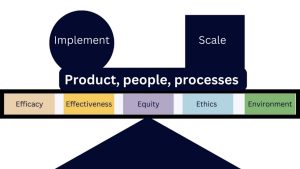For some time, the philanthropic sector has grappled with perplexing dichotomies in leveraging education technology (EdTech) to impact children’s learning. Should EdTech investments prioritize bolstering fundamental learning skills such as literacy and mathematics, or should they foster the dispositions crucial for broader competencies like creativity and critical thinking? Should funding be allocated towards quantifiable proof of EdTech’s impact through experiments, or towards participatory research in local communities? As the field strives to strike a balance between these approaches, a new imbalance is emerging: a narrow understanding of evidence of which approach works best.
One way of understanding impact is to measure the efficacy of an EdTech’s product, that is the added value of using the tool when measured under controlled conditions. Another way is to evaluate the EdTech’s tool in real environments, with teachers’ direct input in how the technology is used. Evidence of EdTech following both approaches – efficacy and effectiveness – are widely demanded by philanthropic organisations when making investment decisions.
Here, the philanthropic sector increasingly aligns with recognized standards of evidence (e.g. ESSA standards in USA, Tulna standards in India). This is important and should continue. However, the question of whether a product works for children’s learning or social outcomes, is only one part of the evidence story. There should be a parallel increase in an acknowledgment of impact measures that extend beyond a product’s effects on educational outcomes.
The Ethics, Equity and Environmental dimensions of impact
The 5Es framework of evidence highlights five areas of impact, including efficacy and effectiveness but also as equity (ensuring outcomes for all), ethics (implementing human-centered, ethically sound data mining and unbiased design), and environmental considerations regarding transferability (ensuring eco-friendly expansion of EdTech use cases). Achieving balance in holistic impact becomes attainable when there is a distribution across all five dimensions of the 5Es, rather than solely striving for excellence in one.
In particular, the relationship between digital and green education, the ethics of using generative AI or questions of how the tools impact historically disadvantaged communities, must be adequately addressed. This implies shifting the focus from product only to people and processes involved in an EdTech’s intervention.
People, product, processes
While a product may be highly efficacious in one classroom, the people implementing it in another school may exclude children with specific educational needs. Furthermore, the process of scaling the product may damage local and wider environments. Prioritizing the implementation of products based solely on outcomes, or overlooking the significance of processes and the people involved in achieving these outcomes, is therefore inadequate.
Instead, sustainable approaches to EdTech impact distribute efforts across all five dimensions of the 5Es framework, emphasizing the involvement of people and processes alongside product excellence. The Jacobs’ Foundation Evidence framework focused on effectiveness, implementation and transferability is an example of such a holistic approach.
How can this balance be achieved?
Much greater impact investments than those currently available, are needed for capacity building that enable the integrations between people, product, and processes across the 5Es dimensions.
Through strategically funded work with schools, educators, and local research teams, progress can be made in understanding how solutions function, for whom, and in what contexts. Furthermore, layered funding to support a common set of 5E goals could strengthen the scalability of EdTech solutions that support both children’s education and planetary health.
Philanthropic organizations, together with governments and in collaboration with local communities, can drive genuine progress by uniting funding and policy-making. Ecosystem-building mechanisms such as embracing alliances and leveraging networks are essential strategies for consolidating the field and distributing funding proportionally across all areas of impact. Such a holistic approach to impact holds the promise to not only address outdated dichotomies but also shape new narratives in the ever-evolving landscape of EdTech.
Natalia I. Kucirkova is Professor of Early Childhood Education and Development at the University of Stavanger, Norway and The Open University, UK







Comments (0)